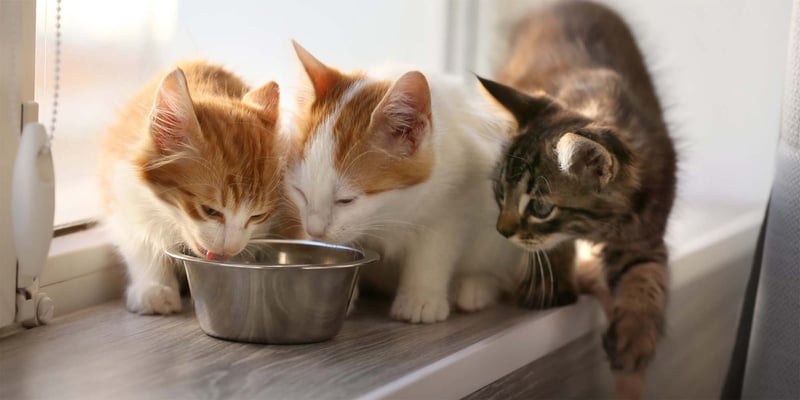Cat Food Allergies - Main Symptoms and What to Look For
Index:



Introduction
Cat food allergies refer to adverse reactions and immune responses to certain food ingredients in a cat's original diet, leading to symptoms like itchy skin, digestive issues, vomiting, and even respiratory problems. Common food allergens include proteins like chicken and fish, grains and food additives, including artificial additives.
Recognising symptoms and seeking a diagnosis of food allergies through veterinary advice is the best way to ensure proper treatment for food allergies. By avoiding food allergens and opting for hypoallergenic food, pet owners can manage cats with food allergies effectively, contributing to their cat's long-term health, comfort, and happiness.
In this blog post we’re taking a look at:
Understanding cat food allergies
Recognising symptoms
How to diagnose allergies
How to manage allergies
Understanding cat food allergies



Cat food allergies refer to allergic responses triggered by specific food ingredients in a cat's diet. These reactions lead to a range of symptoms of food allergies, such as skin infections, gastrointestinal symptoms, and respiratory problems. The immune system's allergic response to certain proteins, food additives or other components in the pet foods causes discomfort and health issues in affected cats.
Cat food allergies arise when a cat's immune system wrongly identifies certain proteins or other components in their diet as harmful invaders. Instead of tolerating these substances, the immune system reacts by releasing histamines and other chemicals, leading to allergic symptoms.
Common foods associated with cat food allergies include:
Beef: Beef protein can trigger allergic reactions in some cats, causing symptoms like skin itching, gastrointestinal distress, and ear infections.
Fish: Fish, especially salmon and tuna, is another common allergen. Cats may experience vomiting, diarrhoea, or skin issues upon consumption.
Chicken: Chicken is a prevalent protein source in cat food, but some cats develop allergies to it, resulting in similar allergic reactions as seen with beef and fish.
Dairy: Many adult cats are lactose intolerant, which can lead to digestive problems when consuming dairy products, including milk and cheese.
Genetic predisposition plays a role in cat food allergies. Certain breeds might be more prone to developing allergies due to their genetic makeup. Additionally, environmental factors such as exposure to allergens during early life can influence the development of allergies.
Cats with a family history of allergies are more likely to experience them themselves. Other environmental factors like pollen, dust mites, and environmental pollutants can also contribute to the development of allergies or exacerbate existing ones. Many vets recommend placing your cat on a hypoallergenic diet. Luckily for you, we’ve got a blog post all about that.
Recognising cat food allergy symptoms



Cat food allergy symptoms show up very physically, often on the skin and in the form of dermatitis - a condition where your cat's skin becomes a battleground of itching, inflammation, and irritation. You might notice your cat scratching themselves relentlessly whilst their skin might look red, swollen, and irritated, giving them an overall unsettled appearance.
Persistent scratching and itchy skin are major red flags for cats with food allergies. Unlike a flea allergy, which may come and go, the itchiness and discomfort from food sensitivities and adverse food reactions are constant. They're also unlike other temporary itches from a random bug bite, as this itching sticks around, becoming a frustrating part of your cat's daily life. Imagine them incessantly scratching, gnawing, and licking at their fur, desperate for relief.
Over time, this unyielding scratching can lead to skin inflammation – a painful consequence of their immune system's struggle with allergens in their food. This constant irritation not only causes discomfort but can also result in a condition known as‘ over-grooming’.
Over-grooming might sound innocuous, but it's far from harmless. Picture your cat compulsively licking and chewing their own fur, often in the same spots over and over. This repetitive behaviour, driven by the maddening itch, can lead to more than just bald patches. The constant licking and chewing can break the skin's barrier, creating small wounds, abrasions, and even raw areas. In severe cases, you might notice your cat's once-lustrous coat turning patchy and uneven due to hair loss caused by this relentless grooming.
Cat food allergies don't limit themselves to the skin; they can also extend to the digestive system leading to your cat experiencing bouts of vomiting or diarrhoea. These gastrointestinal signs are like a silent distress signal, indicating that something isn't quite right with their digestion. Their tummy might be upset, and they may show signs of discomfort or reluctance to eat. It's important to recognise these signs, as they offer insights into your cat's overall well-being and can guide you towards seeking proper veterinary care.
Diagnosing cat food allergies



When your cat seems to be dealing with mysterious discomfort, the elimination diet trial steps in as a savvy detective on the case. This method is all about finding out which ingredients in your cat's food are causing all the fuss. Think of it as a culinary reset – you're offering your cat a new menu, minus the usual suspects, to help them catch a break from the itchiness and irritations.
But, here's the catch: you've got to stick to the new diet like glue. Try to think of it as a secret mission to make sure your cat only eats what's on the ‘approved’ list. Tiny nibbles of forbidden treats? Nope, they're off-limits. Why the strictness? Well, the idea is to give your cat's immune system a proper reset. Any accidental encounters with allergens can muddle up the investigation, making it harder to nail down the real troublemakers.
After your cat has been on their special diet for a while, your vet might suggest a controlled experiment. You'll be like a scientist in your own kitchen, reintroducing possible allergens one by one. Watch closely for any symptoms making a comeback – the itching, the redness, the tummy troubles. If the pesky issues reappear when a particular food is back on the menu, you've got yourself a prime suspect. This food challenge is like the final puzzle piece that confirms the results of the elimination diet trial. With this detective work done, you'll be armed with the info you need to craft a diet that keeps your kitty's tail wagging and their skin itch-free.
Managing cat food allergies



Sadly, cat food allergies aren't exactly the disappearing act kind. They're more like those constants in life you can't change, but you can work around them. Think of it like understanding that rainy days happen, but you've got your trusty umbrella ready.
So, no magical remedy here. But don't fret – you're the one in charge of your cat's meal plan. Your task? Avoid the ingredients that trigger those allergy signals. Skipping those culprits is like giving your cat a backstage pass to an itch-free, belly-happy life.
Now, onto the long-term game – it's all about having a solid strategy. Once you've decoded the allergy puzzle, your job shifts to crafting meals that keep your feline pal smiling. You become the master of ceremonies, making sure every bite avoids the troublemakers. It might sound like a task, but believe us, it's a win-win. By staying on top of their menu, you're giving your cat comfort and top-notch health – all wrapped up in a bowl of goodness. So whilst you can't make allergies vanish, you're definitely the boss of managing them through smart food choices!
Managing cats with food allergies also involves avoiding certain human foods that cats may be tempted by but are not part of a balanced diet suitable for them. Pet food companies offer a range of hypoallergenic food options for cats dealing with allergies. Environmental allergens can also exacerbate symptoms, so it's crucial to consider these aspects as well.
Conclusion



Whilst cat food allergies might stick around, you're far from powerless. You've now got the know-how to handle them like a champ and ensure your furry friend stays comfy and content.
Always keep an eye out for those telltale signs – the incessant scratching, the tummy woes – they're your clues. Armed with this insight, you're ready to curate a diet that fits your cat like a glove, promoting their happiness and health.
But don’t worry, there’s no need to go solo on this journey! Your ultimate ally is your vet. If you even suspect a food allergy might be in play, reach out. A quick chat with them can put things on the right track and guarantee your cat receives the top-notch care they deserve.
So, stay alert for those symptoms, cook up a tailored meal plan, and know that you've got this, cat caregiver. If you ever have a wobble, why not reach out to Joii? They’re a free, 24/7 online vet care provider that can help solve any problem without you needing to leave the house.
Joii is available to all Waggel members, so if you’ve been thinking of insuring your cat, take this as your sign.
FAQs
What is the most common food allergy in cats?
The most common food allergies in cats are typically associated with beef, fish, chicken, and dairy.
How do you tell if my cat is allergic to his food?
Signs of a food allergy can include chronic itching, skin inflammation, overgrooming, hair loss, and sometimes gastrointestinal issues like vomiting or diarrhoea.
Do I need a special diet for my itchy cat?
During a diagnosis for feline food allergies, it is common to put the cat on restricted diets to identify the type of food causing any allergic diseases or inflammatory bowel disease.
As with many other health conditions, your vet may guide you on how to reintroduce specialised feline foods, including both wet food and dry food, to isolate the common food allergens.
What foods should you avoid if you have cat allergies?
Foods commonly associated with allergies in cats include beef, fish, chicken, and dairy. However, each cat is unique and may have different allergens.
Waggel Pet Insurance
Need more help? You're in luck if you're a Waggel Pet Insurance member. Along with our excellent coverage, we offer access to a 24/7 online vet to answer all your sticky questions, especially if you need grooming assistance.
Not a member? Why not get a quote now and cover your furry friend for a range of illnesses, all while enjoying our amazing perks and rewards.
Want more like this?
Get updates from us with helpful info, advice, answers to frequently asked questions and much more.
Index:
Related posts:
Get your quote
Along with our excellent coverage, we offer access to a 24/7 online vet to answer all your sticky questions.





